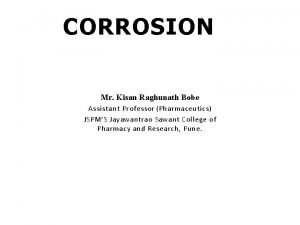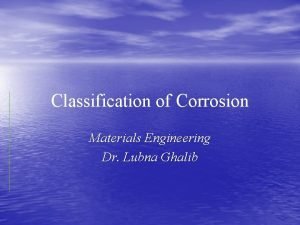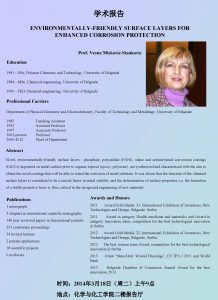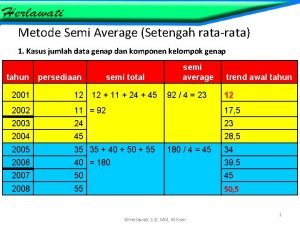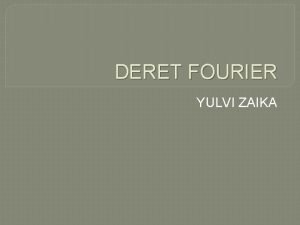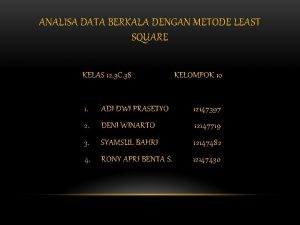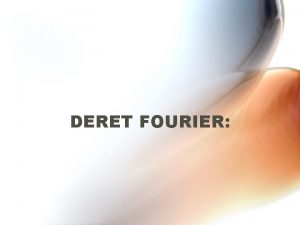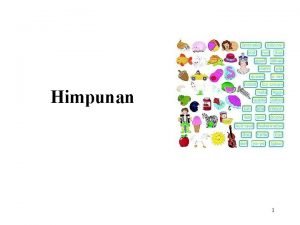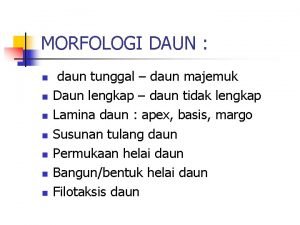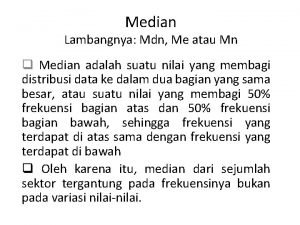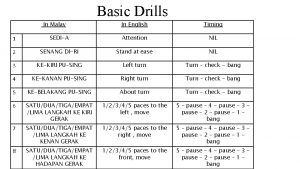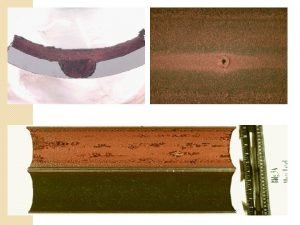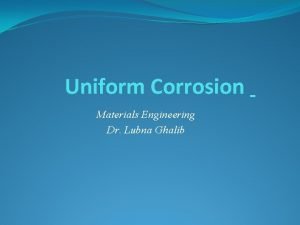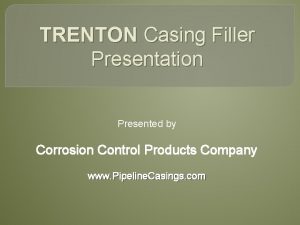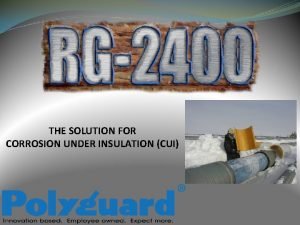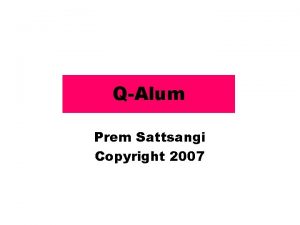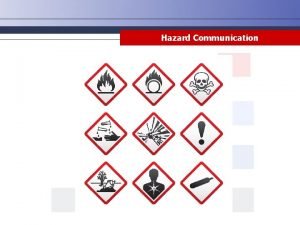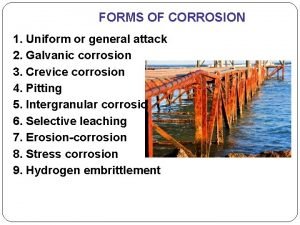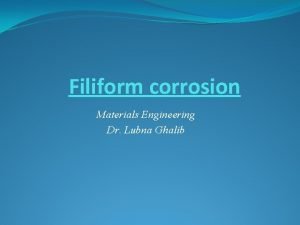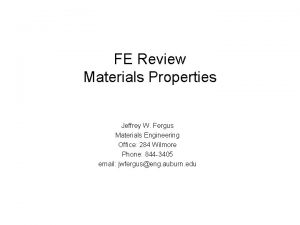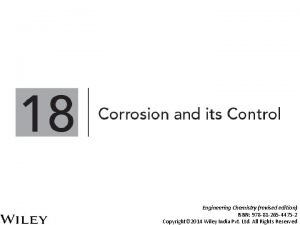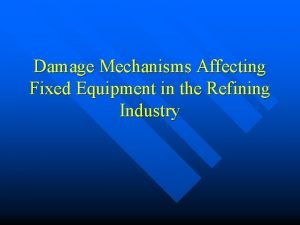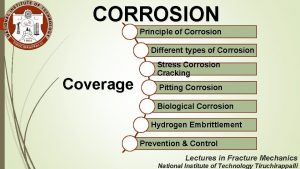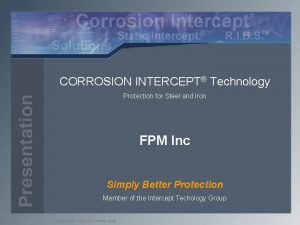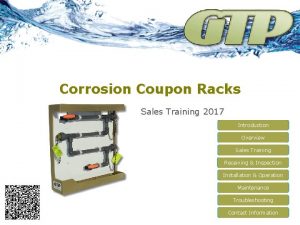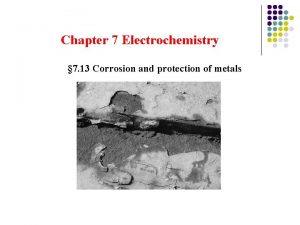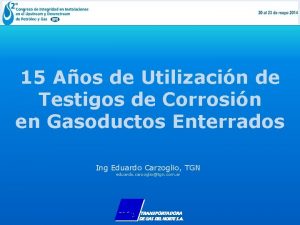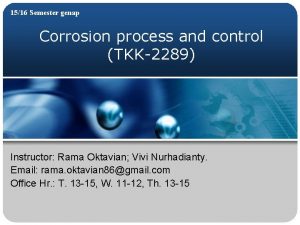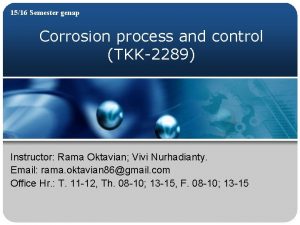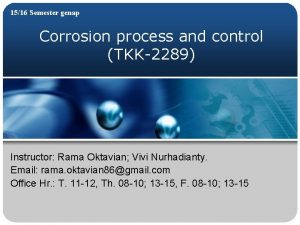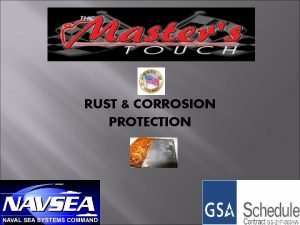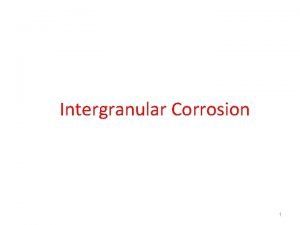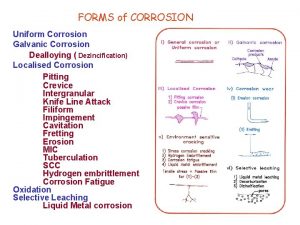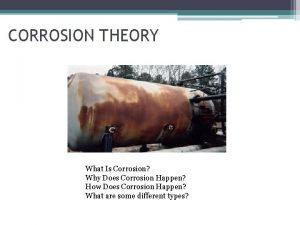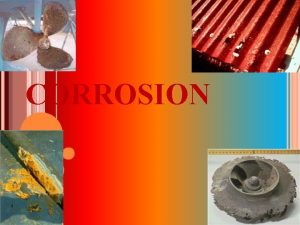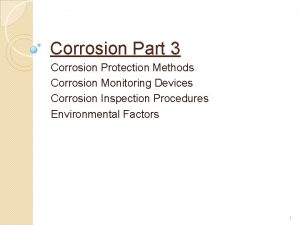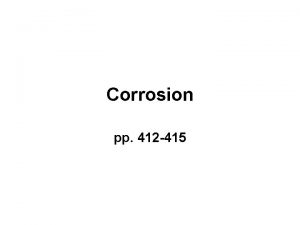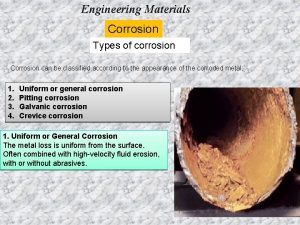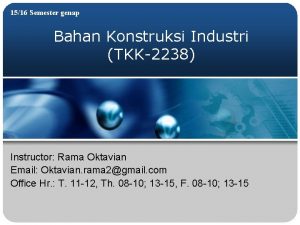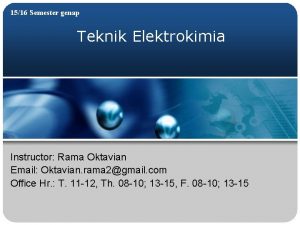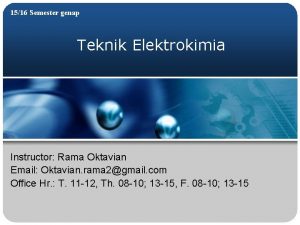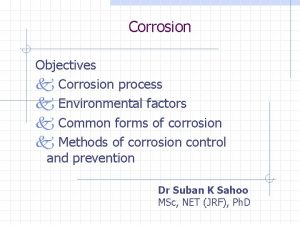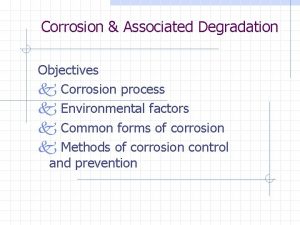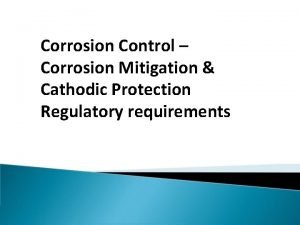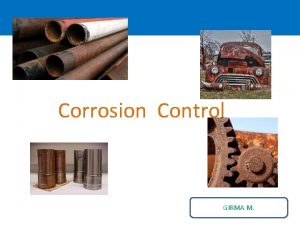1516 Semester genap Corrosion process and control TKK2289































- Slides: 31

15/16 Semester genap Corrosion process and control (TKK-2289) Instructor: Rama Oktavian; Vivi Nurhadianty. Email: rama. oktavian 86@gmail. com Office Hr. : T. 11 -12, Th. 08 -10; 13 -15, F. 08 -10; 13 -15

Corrosion types Stress Corrosion Cracking - the failure of a metal resulting from the co-joint action of stress and chemical attack. - a combination of static tensile stress, environment and a metallurgical condition which leads to component failure. - characterized by fine cracks which lead to failure of components are potentially the structure concerned. - Under tensile stress, and in a suitable environment, some metals and alloys crack. . .

Corrosion types Stress Corrosion Cracking Requirement for SCC: - A susceptible metal. - A specific environment - A tensile or residual stress.

Corrosion types Stress Corrosion Cracking • Common sources of tensile stresses are: 1: External stresses caused by • Centrifugal forces • Temperature variation 2: Residual stresses due to • Forming • Heat treatment • Welding • Machining • Grinding

Corrosion types Stress Corrosion Cracking Application of fracture mechanics The fracture toughness of most materials is determined by a parameter called ‘stress intensity factor, ’ Ki Failure occurs when the stress intensity factor reaches a critical value, K 1 c

Corrosion types Stress Corrosion Cracking Application of fracture mechanics Failure occurs when the stress intensity factor reaches a critical value, K 1 c

Corrosion types Stress Corrosion Cracking Types of SCC: - Chloride stress corrosion cracking - Caustic stress corrosion cracking - Sulfide stress corrosion cracking - Seasonal cracking

Corrosion types Stress Corrosion Cracking Types of SCC:

Corrosion types Stress Corrosion Cracking Types of stress in SCC:

Corrosion types Stress Corrosion Cracking

Corrosion types Stress Corrosion Cracking SCC mechanism: The following are generally the sites for crack initiation. - Surface discontinuities - Corrosion pits - Grain boundaries

Corrosion types Stress Corrosion Cracking § The process of SCC consists of three stages: – Crack Initiation – Crack Propagation – Brittle Fracture

Corrosion types Stress Corrosion Cracking § The process of SCC consists of three stages: – Crack Initiation SCC is initiated by stress concentrations at defects on the material surface. The defect may be an existing material defect. The defect may also be a result of pitting corrosion, crevice corrosion, intergranular corrosion or local galvanic corrosion.

Corrosion types Stress Corrosion Cracking § The process of SCC consists of three stages: – Crack Initiation

Corrosion types Stress Corrosion Cracking § The process of SCC consists of three stages: – Crack Propagation The passivation film at the tip of the crack is broken due to plastic deformation. Pure and normally very active metal is exposed and will be attacked by corrosion. Grow rate will be a combination of corrosion and cracking. The crack starts to grow when the stress concentration at the end of the crack (KI) exceeds the threshold stress intensity factor for stress corrosion cracking (KISCC).

Corrosion types Stress Corrosion Cracking § The process of SCC consists of three stages: – Brittle Fracture When the stress concentration at the end of the crack exceeds the critical stress intensity factor (KI > KIC), there will be a rapid, unstable brittle fracture.

Corrosion types Examples of typical SCC

Corrosion types Examples of typical SCC

Corrosion types Examples of typical SCC

Corrosion types Characteristic of SCC - Stress, either residual or applied, is required. - Generally alloys are susceptible to SCC - SCC of a specific alloy is caused by only a few chemical species in the environment. - Conditions of cracking are specific to alloy and environment. - The mode of cracking may be intergranular or transgranular. - SCC cracks are microscopically brittle in appearance.

Corrosion types Environmental and materials factor in SCC

Corrosion types Mechanism of SCC - Mechano–electrochemical model - Film rupture model - Embrittlement model - Adsorption model

Corrosion types Mechanism of SCC - Mechano–electrochemical model a grain boundary precipitate anodic to the grain boundary would provide an active path for localized corrosion to proceed. the removal of the protective film at the crack tip by plastic deformation would facilitate the onset of localized corrosion.

Corrosion types Mechanism of SCC - Film rupture model based on a repetitive cycle comprising (a) localized film disruption, (b) localized attack at the point of disruption and (c) film repair. - Embrittlement model based on the postulate that an electrochemical process embrittles the materials in the vicinity of a corroding surface. - Adsorption model Adsorption of damaging species causes weakening of cohesive bonds between surface metal atoms by specific damaging species.

Corrosion types Effect of environmental factors on SCC - Specific ions Not all environments promote SCC and hence, the environments causing SCC are specific.

Corrosion types Effect of environmental factors on SCC - Effect of oxygen is essential for SCC to take place. Oxygen only acts as a reducible species - Role of hydrogen role of hydrogen in SCC is very crucial

Corrosion types SCC in stainless steel

Corrosion types SCC in steel - Effect of Alloy Composition

Corrosion types SCC in steel - Effect of temperature The susceptibility of austenitic steels to SCC increases with temperature.

Corrosion types SCC in steel - Stress level SCC would never occur in the absence of either corrosive environment or stress. SCC can occur both by residual and tensile stress. - Effect of chloride concentration

 Differentiate between dry corrosion and wet corrosion
Differentiate between dry corrosion and wet corrosion Dry corrosion and wet corrosion
Dry corrosion and wet corrosion Materi akidah akhlak kelas 7 semester genap
Materi akidah akhlak kelas 7 semester genap Corrosion control solutions
Corrosion control solutions Product vs process
Product vs process Metode semi average
Metode semi average Metode semi rata-rata
Metode semi rata-rata Contoh soal deret fourier fungsi periodik
Contoh soal deret fourier fungsi periodik Contoh metode least square data genap
Contoh metode least square data genap Metode trend setengah rata-rata data ganjil genap
Metode trend setengah rata-rata data ganjil genap Soal deret fourier
Soal deret fourier Diantara bilangan bulat antara 101 - 600
Diantara bilangan bulat antara 101 - 600 Daun majemuk menyirip genap
Daun majemuk menyirip genap Rumus median
Rumus median Nombor genap in english
Nombor genap in english Mechanism of wet corrosion
Mechanism of wet corrosion Uniform corrosion mechanism
Uniform corrosion mechanism Corrosion prevention casing filler
Corrosion prevention casing filler Corrosion under insulation primer
Corrosion under insulation primer Aluminium corrosion equation
Aluminium corrosion equation Skin corrosion symbol
Skin corrosion symbol Uniform attack
Uniform attack Filiform corrosion
Filiform corrosion Brittle failure
Brittle failure Galvanic corrosion
Galvanic corrosion Sulfidation corrosion
Sulfidation corrosion Corrosion principle
Corrosion principle Corrosion intercept
Corrosion intercept Corrosion coupon rack flow rate
Corrosion coupon rack flow rate Corrocean corrosion monitoring
Corrocean corrosion monitoring Waterline corrosion
Waterline corrosion Testigos de corrosión
Testigos de corrosión
